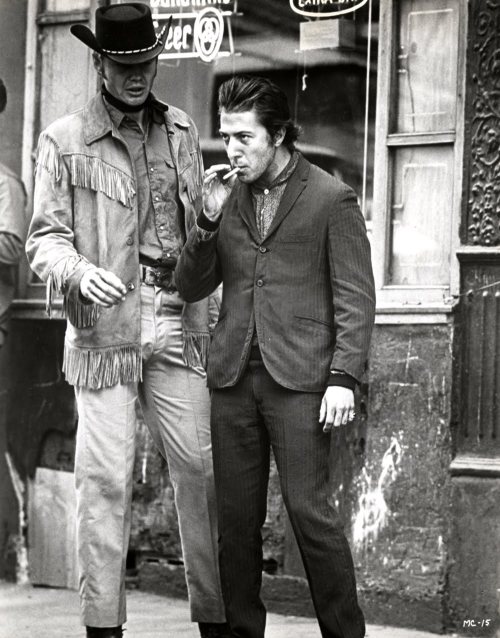 |
| Promotional still from the movie |
"Midnight Cowboy" is a film directed by John Schlesigner in 1969. It stars Dustin Hoffman as Ratso and Jon Voight as Joe Buck. I entered the viewing of this film with absolutely no information on it. I was aware that Dustin Hoffman acted in it, but the plot eluded me, so upon my viewing I was pleasantly surprised at what I found.
It is a story of a over eager "cowboy," Joe Buck, who desperately wants to make money. He abandons him job in Texas and moves to New York City to become a male hustler. Joe is naive and unexperienced in the field he wishes to enter, so once he arrives in the Big Apple, he is in for a rude awakening. He is easily taken advantage of by his first customer, and then a slimy Ratso cons him out of $20. He is left penniless and on the streets, resorting to desperate measures to earn any sort of money. Eventually Joe and Ratso reunite and plan to make Joe into an irresistible male companion for all the lonely New York women. The duo never seem to have any success, and them film ends with Ratso's tragic death, leaving the viewer feeling unfulfilled.
I thoroughly enjoyed this film. I was very excited when it turned out not being about a cowboy on a horse in the middle of the desert. Instead it tackled some very serious topics, such as the modern condition of a society and how difficult it is to become successful in the wake of the late 60's with all the forces of nature pushing you towards failure. Joe Buck is fighting against an infrastructure that has been in place for decades and it is entirely impossible for him to break in to. There is also the fact of repression and how Joe is not only escaping Texas to find a new job, but because of a past that is so traumatic that is sits in his subconscious, subtly eating away at his sanity.
Stylistically, what made the film unique was it's editing. It used a form of montage in which images and frames were spliced together to create a dramatic and unsettling feeling. This montage style of editing was most effective during moments when Joe was unwillingly coming face to face with his past. Joe, in his shocked and unhinged state, would retreat back into his mind and the images that flashed upon the screen were from the event from his past that changed his life. As the film progresses, Joe has more and more of these visions in which he must face his past. Each time, the audience is given a little bit more information to go on, until finally realizing just what happened to Joe that made him so desperate to become a prostitute.
I thoroughly enjoyed this film and would suggest it to any one who is interested in a unique look into the time of the late 60's. I give this film a A.
No comments:
Post a Comment